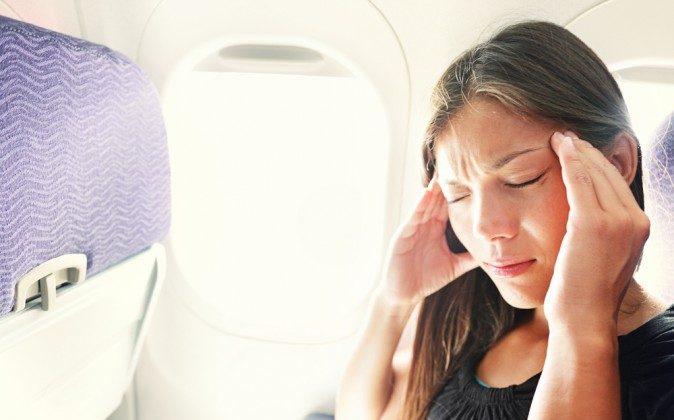Sure, we all know that due to having hundreds of people packed into an enclosed space for a long period of time, we’re more likely to catch a virus, and most of us have heard of Deep Vein Thrombosis (DVT), which can result in blood clots after passengers are forced to sit in small spaces for long durations of time. But there other health risks of flying you may not yet be aware of.
Severe Dehydration
Aircraft air is so dry that on a long-haul flight, a passenger should consume about a pint of water every three hours.
That may seem a lot—but don’t forget: on the ground we also consume fresh fruit and veg, which contributes to our water intake during the day. This extra H2O is certainly not provided by the tiny meals and limited range of drinks served by most airlines. Indeed, drinking the tea, coffee and alcohol commonly offered on flights will only worsen the problem of dehydration, which can cause severe headaches, parched skin and lips and a sense of fatigue. Having dehyrated mucous membranes (especially in the nose) leaves us more vulnerable to airborne viruses.
To combat these threats, drink lots of water—and nothing but water—on your flight, and bring an organic facial spray, like those by Luxsit or AEOS, to mist your face throughout the flight. For extra peachy skin when you land, smooth on an ‘invisible’ face masque, like Aromatherapy Associates’ rose mask, and wash off when you land.

Lung Damage from Breathing in Polluted Air
You obviously can’t open windows on the plane, so air is drawn in by the engine (umm…isn’t that where the fumes are?) and channelled into the interiors instead. But many airlines try to conserve fuel by recycling internal air several times—meaning there’s a serious lack of clean air. This is often at its worst when the take-off is delayed, when the passengers remain on a stationary aircraft: because the engines aren’t running, there is little ventilation and the air becomes increasingly fetid. The airlines claim that, once airborne, there is not a problem, because there are filters to purify the air as it recirculates. But there is little proof that filtering systems perform this job effectively.
Moreover, some airlines spray ‘antiviral’ and ‘antibacterial’ sprays in the cabin, which can be a danger to asthmatics and those with other breathing difficulties. No one is sure what goes into those sprays, but unless someone can prove otherwise to us, we’re pretty sure those fumes are toxic (the one airline we contacted on this matter, Air France, assured us with a snap that ’the spray is perfectly safe'. End of conversation!)
While there is little you can do on the flight to avoid breathing in pollution, we believe the government and aviation regulators should be monitoring air quality and aircraft filtration systems far more closely, and if an aircraft is subject to delay before take-off, there should be the immediate disembarkation of passengers if the delay is longer than half an hour.

Lice and Bedbugs
As anyone with a school aged kid knows, lice can spread like wildfire, and the fact that aircraft blankets and headrests are not cleaned between flights (yes, really) allows for them to thrive, especially when flights go to and from countries that have particularly high infestation rates. Each individual plane can fly between two to eight trips per day, depending on the size of the aircraft and distance of travel. A plane can take 4-16 flights in two days. This means that over a dozen people may have sat in your seat before you—and lice can live for up to two days without a food source.
To reduce your risk, spray your seat with pure peppermint or Tea Tree oil (which these bugs hate) and of course, BYOB (bring your own blanket).

Increased Cancer Risk
It’s long been suspected that jetsetters are at a higher risk of cancer, but compelling new evidence has reinforced the theory beyond a doubt. Studies show that stewardesses could be up to five times more likely to contract breast cancer, and cabin crew of both sexes are three times more likely to get melanoma. Why? Apparently, there are two main reasons.
First, long-haul trips disrupt the body clock and affect hormone levels, which can lead to chemical imbalances in the body that leave us vulnerable to tumour growth. Secondly, at higher altitudes, where the air is thinner and provides less of a shield, passengers and crew can be exposed to between 100 and 300 times the radiation dose they receive at sea level. In fact, British experts estimate that airline crews receive a higher dose of radiation over a year than workers in the nuclear industry.
In one Swedish study, for example, cases of malignant melanoma were between two and three times higher than the norm for both male and female cabin crew, and breast cancer cases were 30 per cent higher. The researchers estimated that childbearing patterns would result in only a 10 per cent extra risk of breast cancer. In another survey in Iceland, more than 1,000 pilots and flight attendants were compared with 2,000 people in the general population and researchers made a detailed analysis of risk factors for skin cancer. The study concluded that those working on airplanes clearly had an increased risk of melanoma.
But Dr Elizabeth Whelan, of the U.S. Centers for Disease Control and Prevention, writing in the Occupational and Environmental Medicine journal, said: ‘There is mounting evidence that cabin crew have an increased risk of melanoma and breast cancer because the average amount of exposure to radiation had increased over time as planes flew higher and for longer, but irregular working hours and disturbances to the body clock were other factors that could trigger health problems.
While cabin crew obviously fly more than the average person, it’s well worth remembering that flying less will not only protect the planet by reducing your carbon footprint and the amounts of CO2 emitted into the atmosphere, but may also protect your health as well.
This article was originally published on eluxemagazine.com. Read the original here.





